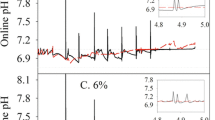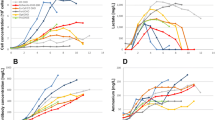Abstract
Apart from gas concentrations, temperature, and pH, generally only the initial conditions can be manipulated in batch culture. Inoculum size and initial conditioned medium concentration represent two important considerations for optimal batch production. Two hybridoma cell lines were used to assess the impact of these initial conditions on population growth and monoclonal antibody productivity in suspension batch culture. Varying initial cell concentration over the range of 1.0 × 105 cells mL-1 to 3.0 × 105 cells mL-1 did not affect maximum product titre or maximum volumetric cell-hours attained. Initial percent of conditioned medium up to 40 percent strongly impacted on population growth and productivity, with initial levels of 30 to 40% conditioned medium reducing or eliminating lag phase and increasing average viable cell density. However, specific productivity and product titre declined with increasing initial percent conditioned medium, even on a per volume of fresh medium basis. Glutamine and glucose depletion or ammonia toxicity could cause depressed product titres when conditioned medium is used. Glutamine and glucose levels can easily be replenished in conditioned medium at minimal cost, and ammonia can be removed. Specific productivity was higher during cyclic batch operating mode than during batch operating mode. This may be because cyclic batch operating mode results in an incidental volume of conditioned medium at the beginning of each cycle. A two stage, cyclic-batch/batch operating mode can be employed to fully utilize medium and maximize product titre.
Similar content being viewed by others
References
Bosworth JM, Brimfield AA, Naylor JA and Hunter Jr KW (1983) Measurement of monoclonal antibody concentrations in hybridoma cultures: Comparison of competitive inhibition and antigen capture enzyme immunoassays. J Immunol Method 62: 331-336.
Butler M (1986) Serum-free media. In: Thilly WG (ed) Mammalian Cell Technology, Butterworths Publishers, United States, pp. 91-108.
Chuck AS and Palsson BO (1992) Population balance between producing and non-producing hybridoma clones is very sensitive to serum level, state of inoculum, and medium composition. Biotech Bioeng 39: 354-360.
Dutton RL, Scharer JM and Moo-Young M (1998) Descriptive parameter evaluation in mammalian cell culture. Cytotechnology 26: 139-152.
Frame KK and Hu W-S (1991a) Kinetic study of hybridoma cell growth in continuous culture I. A model for non-producing cells. Biotech Bioeng 37: 55-64.
Frame KK and Hu W-S (1991a) Kinetic study of hybridoma cell growth in continuous culture II. Behavior of producers and comparison to nonproducers. Biotech Bioeng 38: 1020-1028.
Gaertner JG and Dhurjati P (1993) Fractional factorial study of hybridoma behavior. I. Kinetics of growth and antibody production. Biotechnol Prog 9: 298-308.
Glacken MW, Adema E and Sinskey AJ (1988) Mathematical descriptions of hybridoma culture kinetics: I. Initial metabolic rates. Biotech Bioeng 32: 491-506.
Griffiths JB (1987) Serum and growth factors in cell culture media — An introductory review. Develop Biol Stand 66: 155-160.
Hayward GL, Scharer JM, Moo-Young M and Bols NC (1991) Photometric ELISA calibration for antibody assay. Bio Techniques 5: 35-38.
Jeong Y-H and Wang SS (1995) Role of glutamine in hybridoma cell culture: Effects on cell growth, antibody production, and cell metabolism. Enzyme Microb Technol 17: 47-55.
Kempken R, Buntemeyer H and Lehmann J (1991) The medium cycle bioreactor (MCB): Monoclonal antibody production in a new economic production system. Cytotechnology 7: 63-74.
Kim JH, Bae SW, Hong HJ and Lee GM (1996) Decreased chimeric antibody productivity of KR12H-1 transfectoma during long-term culture results from decreased antibody gene copy number. Biotech Bioeng 51: 479-487.
Kunas KT and Papoutsakis ET (1989) Increasing serum concentrations decrease cell death and allow growth of hybridoma cells at higher agitation rates. Biotech Lett 10: 625-628.
Laufenburger D and Cozens C (1989) Regulation of mammalian cell growth by autocrine growth factors: Analysis of consequences for inoculum cell density effects. Biotech Bioeng 33: 1365-1378.
Lee GM, Kaminski MA and Palsson BO (1992) Observations consistent with autocrine stimulation of hybridoma cell growth and implications for large-scale antibody production. Biotech Lett 14: 257-262.
Lee GM, Huard TK and Palsson BO (1989) Effect of serum concentration on hybridoma cell growth and monoclonal antibody production at various initial cell densities. Hybridoma 8: 369-375.
Mariani E, Mariani AR, Monaco MCG, Lalli E and Facchini A (1991) Commercial serum-free media: Hybridoma growth and monoclonal antibody production. J Immunol Methods 145: 175-183.
Martens DE, Sipkema EM, de Gooijer CD, Beuvery EC and Tramper J (1992) Effect of serum concentration on hybridoma viable cell density and production of monoclonal antibodies in CSTR'S and on shear sensitivity in air-lift loop reactors. Biotech Bioeng 39: 891-897.
Matsumura M and Nayve Jr. FRP (1995) Effects of ammonium ion removal on growth and MAb production of hybridoma cells. Cytotechnology 18: 35-50.
McKinney KL, Dilwith R and Belfort G (1991) Manipulation of heterogeneous hybridoma cultures for overproduction of monoclonal antibodies. Biotechnol Prog 7: 445-454.
Miller WM, Blanch HW and Wilke CR (1988) A kinetic analysis of hybridoma growth and metabolism in batch and continuous suspension culture: Effect of nutrient concentration, dilution rate, and pH. Biotech Bioeng 32: 947-965.
Ozturk SS and Palsson BO (1990a) Effect of initial cell density on hybridoma growth, metabolism, and monoclonal antibody production. J Biotechnol 16: 259-278.
Ozturk SS and Palsson BO (1990b) Chemical decomposition of glutamine in cell culture media: Effect of media type, pH, and serum concentration. Biotechnol Prog 6: 121-128.
Ozturk SS, Riley MR and Palsson BO (1992) Effects of ammonia and lactate on hybridoma growth, metabolism, and antibody production. Biotech Bioeng 39: 418-431.
Park SY and Lee GM (1995) Enhancement of monoclonal antibody production by immobilized hybridoma cell culture with hyperosmolar medium. Biotech Bioeng 48: 699-705.
Phillips HA, Scharer JM, Bols NC and Moo-Young M (1992) Design and performance of a trickle-bed bioreactor with immobilized hybridoma cells. Cytotechnology 9: 29-40.
Phillips HA (1991) Evaluation of hybridoma culture systems. PhD Thesis. Department of Chemical Engineering, University of Waterloo, Waterloo, Canada.
Phillips HJ (1973) Dye exclusion tests for cell viability, In: Kruse Jr PF and Patterson Jr MK (eds) Tissue Culture: Methods and Applications. Academic Press, New York, pp. 406-408.
Rein A and Rubin H (1968) Effects of local cell concentrations upon the growth of chick embryo cells in tissue culture. Exp Cell Res 49: 666-678.
Reuveny S, Valez D, Macmillan JD and Miller L (1986) Factors affecting cell growth and monoclonal antibody production in stirred reactors. J Immunol Methods 86: 53-59.
Riese U, Lutkemeyer D, Heidemann R, Buntemeyer H and Lehmann J (1994) Re-use of spent cell culture medium in pilot scale and rapid preparative purification with membrane chromatography. J Biotechnol 34: 247-257.
Rubin H (1966) A substance in conditioned medium which enhances the growth of small numbers of chick embryo cells. Exp Cell Res 41: 138-148.
Sanfeliu A, Cairo JJ, Casas C, Sola C and Godia F (1996) Analysis of nutritional factors and physical conditions affecting growth and monoclonal antibody production of the hybridoma KB-26.5 cell line. Biotechnol Prog 12: 209-216.
Schneider M, Marison IW and von Stockar U (1996) The importance of ammonia in mammalian cell culture. J Biotechnol 46: 161-185.
Shirai Y, Hashimoto K and Takamatsu H (1992) Growth kinetics of hybridoma cells in high density culture. J Ferment Bioeng 73: 159-165.
Takazawa Y, Tokashiki M, Murakami H, Yamada K and Omura H (1988) High-density culture of mouse-human hybridoma in serum-free defined medium. Biotech Bioeng 31: 168-172.
Van Erp R, Adorf M, van Sommeren APG, Schonherr OT and Gribnau TCJ (1991a) Monitoring of the production of monoclonal antibodies by hybridomas. Part I: Long-term cultivation in hollow fibre bioreactors using serum-free medium. J Biotechnol 20: 235-248.
Van Erp R, Adorf M, van Sommeren APG, Schonherr OT and Gribnau TCJ (1991b) Monitoring of the production of monoclonal antibodies by hybridomas. Part II: Characterization and purification of acid proteases present in cell culture supernatant. J Biotechnol 20: 249-262.
Wohlpart D, Kirwan D and Gainer J (1990) Effects of cell density and glucose and glutamine levels on the respiration rates of hybridoma cells. Biotech Bioeng 36: 630-636.
Author information
Authors and Affiliations
Corresponding author
Rights and permissions
About this article
Cite this article
Dutton, R.L., Scharer, J.M. & Moo-Young, M. Hybridoma growth and productivity: effects of conditioned medium and of inoculum size. Cytotechnology 29, 1–10 (1999). https://doi.org/10.1023/A:1008060802286
Issue Date:
DOI: https://doi.org/10.1023/A:1008060802286




